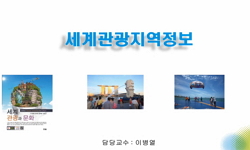The purpose of this study is to propose the method to improve management aspect and facilities plan to enhance spatial cognition of visitors through visitors' analysis of spatial cognition regarding tourism destination facilities. The research model w...
http://chineseinput.net/에서 pinyin(병음)방식으로 중국어를 변환할 수 있습니다.
변환된 중국어를 복사하여 사용하시면 됩니다.
- 中文 을 입력하시려면 zhongwen을 입력하시고 space를누르시면됩니다.
- 北京 을 입력하시려면 beijing을 입력하시고 space를 누르시면 됩니다.

자연환경 기반형 관광·휴양목적지 시설물에 대한 방문객 공간인지도 분석 - 남이섬 관광지 사례를 중심으로 - = Analysis of Spatial Cognition of Visitors to Natural Environment-based Tourism·Resort Facilities - A Case Study of NAMI Island -
한글로보기부가정보
다국어 초록 (Multilingual Abstract)
The purpose of this study is to propose the method to improve management aspect and facilities plan to enhance spatial cognition of visitors through visitors' analysis of spatial cognition regarding tourism destination facilities. The research model was established by factors affecting spatial cognition such as facilities characteristics and visitor characteristics as well as spatial cognition of visitors' facilities to achieve objectives of research, and actual proof analysis was made to visitors to Nami Island tourism destination based of this. As a result of analysis, it was proved that visitor characteristics including their gender and age, and tour map use as well as facilities characteristics of facilities type, location, etc showed a statistically significant difference in visitors' spatial cognition. In addition, it is deemed as a result of analysis that Nami Island requires re-organization of symbolic features and attractiveness of food and beverage facility, while needing additional installment and rearrangement of information facilities and related facilities. The result of this research suggests that close analysis and application of factors affect spatial cognition such as facilities and visitors' characteristics to plan and manage the tourism destination facilities effectively. Moreover, visitors' spatial cognition is related to spatial characteristics of tourism destination, therefore it is analyzed that the uniqueness of facilities played an important role in improving female's spatial cognition. In particular, the result of this study is meaningful in that in light of plan and management for tourism destination facilities, the function to provide tourism destination plays a major role in improving visitors' spatial cognition regardless of complexity of spatial structure of tourism destination.
국문 초록 (Abstract)
본 연구는 관광지 시설물에 대한 방문객의 공간인지도 분석을 통해 방문객의 공간인지도 향상을 위한 시설물 계획 및 관리적 측면의 개선방안과 시사점을 제시하는데 목적이 있다. 연구의 ...
본 연구는 관광지 시설물에 대한 방문객의 공간인지도 분석을 통해 방문객의 공간인지도 향상을 위한 시설물 계획 및 관리적 측면의 개선방안과 시사점을 제시하는데 목적이 있다. 연구의 목적달성을 위해 방문객의 시설물에 대한 공간인지도와 시설물 특성 및 방문객 특성 등의 공간인지도 영향요소에 대한 연구모형을 설정하였으며, 이를 토대로 남이섬 관광지 방문객을 대상으로 실증분석을 수행하였다. 분석결과, 시설물 유형, 입지 등의 시설물 특성과 성별, 연령, 안내지도 사용 등의 방문객 특성이 방문객의 공간인지도와 통계적으로 유의한 것으로 나타났다. 또한 남이섬의 경우에는 식·음료시설에 대한 매력성, 상징성 강화 등의 재정비가 요구되며, 종반부 시설물에 대한 정보제공 시설의 추가설치 및 재배치가 필요한 것으로 분석되었다. 본 연구의 결과는 관광지 시설물의 효율적인 계획과 관리를 위해 시설물 및 방문객 특성 등의 공간인지도 영향요소에 대한 면밀한 분석과 반영의 필요성을 시사한다. 특히, 방문객의 공간인지도는 관광지의 공간적 성격과도 연관성이 있으며, 여성의 공간인지도 향상을 위해 시설물의 독특성이 중요한 요소로 작용하고 있는 것으로 분석되었다. 또한, 본 연구의 결과는 관광지 시설물의 계획과 관리에 있어 관광지 정보제공 기능이 관광지의 공간구조의 복잡성과 관계없이 방문객의 공간인지도 향상을 위해 중요한 요소임을 시사하고 있다.
참고문헌 (Reference)
1 양승정, "한국전통마을 공간구성의 시설배치특징에 관한 연구" 대한건축학회 22 (22): 169-178, 2006
2 변재상, "초고층 랜드마크의 공간적 거리 및 인지강도와의 상관성 분석 - 서울시 30층 이상 고층건물을 대상으로 -" 한국조경학회 35 (35): 90-104, 2007
3 김정민, "중요도-성취도 분석을 기초로 한 관광지 관리방안에 관한 연구 - 강원도 소재 관광지를 중심으로 -" 한국환경생태학회 17 (17): 276-284, 2003
4 정지범, "인지도를 이용한 한ㆍ미 대학캠퍼스 이미지 차이 연구" 국토연구원 51 (51): 131-150, 2006
5 박상훈, "시뮬레이션을 통한 관광지 시설물의 시각적 선호도 차이 분석" 한국관광학회 32 (32): 187-207, 2008
6 김계섭, "문화관광자원의 매력속성, 자원해설, 관광만족간의 영향관계" 대한관광경영학회 19 (19): 247-272, 2004
7 이재곤, "길찾기 행동에 있어서 관광지 환경정보, 인지도, 관광자 만족도의 영향관계에 관한 연구 - 테마파크를 중심으로 -" 관광경영학회 14 (14): 133-158, 2010
8 장은경, "관광지에 대한 관광자 視角 유형: Q방법 적용" 한국관광학회 32 (32): 339-361, 2008
9 김성진, "관광지 재생 - 남이섬 사례 연구 -" 한국관광학회 34 (34): 183-202, 2010
10 이경하, "관광지 속성과 공간마찰력변수가 관광지선택에 미치는 영향" 대한관광경영학회 17 (17): 1-22, 2002
1 양승정, "한국전통마을 공간구성의 시설배치특징에 관한 연구" 대한건축학회 22 (22): 169-178, 2006
2 변재상, "초고층 랜드마크의 공간적 거리 및 인지강도와의 상관성 분석 - 서울시 30층 이상 고층건물을 대상으로 -" 한국조경학회 35 (35): 90-104, 2007
3 김정민, "중요도-성취도 분석을 기초로 한 관광지 관리방안에 관한 연구 - 강원도 소재 관광지를 중심으로 -" 한국환경생태학회 17 (17): 276-284, 2003
4 정지범, "인지도를 이용한 한ㆍ미 대학캠퍼스 이미지 차이 연구" 국토연구원 51 (51): 131-150, 2006
5 박상훈, "시뮬레이션을 통한 관광지 시설물의 시각적 선호도 차이 분석" 한국관광학회 32 (32): 187-207, 2008
6 김계섭, "문화관광자원의 매력속성, 자원해설, 관광만족간의 영향관계" 대한관광경영학회 19 (19): 247-272, 2004
7 이재곤, "길찾기 행동에 있어서 관광지 환경정보, 인지도, 관광자 만족도의 영향관계에 관한 연구 - 테마파크를 중심으로 -" 관광경영학회 14 (14): 133-158, 2010
8 장은경, "관광지에 대한 관광자 視角 유형: Q방법 적용" 한국관광학회 32 (32): 339-361, 2008
9 김성진, "관광지 재생 - 남이섬 사례 연구 -" 한국관광학회 34 (34): 183-202, 2010
10 이경하, "관광지 속성과 공간마찰력변수가 관광지선택에 미치는 영향" 대한관광경영학회 17 (17): 1-22, 2002
11 최영석, "공간구문론에 의한 관광지 시설물의 공간위상학적 특성과 방문객 공간인지와의 관계분석" (사)한국관광레저학회 24 (24): 379-400, 2012
12 문성민, "경복궁 관람객의 공간인지에 관한 연구" (사)한국관광레저학회 18 (18): 209-228, 2006
13 Louviere, J.J., "Using Hierarchical Information Integration to Model Consumer Responses to Possible Planning Actions : Recreation Destination Choice Illustration" 22 : 291-308, 1990
14 Walmsley, D.J., "Tourism Cognitive Mapping of Unfamiliar Environments" 19 : 268-286, 1992
15 Kim, C. G., "The Research on Facilities Management and Operation of Tourist Resort" 6 : 1-31, 2000
16 Kirasick, K, "Spatial cognition and behavior in young and elderly adults: Implications for learning new environments" 6 (6): 10-18, 1991
17 Debbage, K, "Spatial Behavior in a Bahamian Resort" 18 : 251-268, 1991
18 유광민, "Space Syntax를 이용한 관광자원 개발전략 - 양주시 유양동을 중심으로 -" 한국관광학회 33 (33): 75-92, 2009
19 류시영, "MBTI 성격유형에 따른 관광동기와 선호 관광지 유형 차이" 한국관광학회 35 (35): 229-247, 2011
20 KCTI, "Introduction of Residential Facilities for Activating a Tourist Resort Development" 101-, 2009
21 Moor, G.T., "Environmental Knowing: theories, research and methods" Hutchinson & Ross, Inc 1976
22 Bruce, P, "Building Visitor Attractions in Peripheral Area: Can Uniquenness Overcome Isolation to Produce Viability" 4 : 379-389, 2002
23 Yoo, K. M., "Approach of Critical Realism on Location Determinant Structure of Resort" Univ. of Hanyang 2010
24 Kim, C. H., "Analysis of Spatial Recognizability from Mental Map" 10 : 21-41, 1991
25 Ko, D.W., "An Exploration for Consumption Expenditures of Planned Festival Visitors" 2 (2): 61-79, 2001
26 Yoo, C. G., "A Study on the Cognition Structure of University Campuses" 15 (15): 59-68, 1999
27 Newcombe, N., "A Longitudinal study of predictors of spatial ability in adolescent females" 63 : 36-46, 1992
동일학술지(권/호) 다른 논문
-
용문사 계곡 소나무림의 식물군집구조 및 22년간(1988~2010년) 변화 분석
- 한국환경생태학회
- 장재훈
- 2013
- KCI등재
-
- 한국환경생태학회
- 김진석
- 2013
- KCI등재
-
- 한국환경생태학회
- 김지석
- 2013
- KCI등재
-
대도시 생활권 숲길 이용자의 방문동기 및 이용만족 - 대구광역시 숲길을 중심으로 -
- 한국환경생태학회
- 권태호
- 2013
- KCI등재
분석정보
인용정보 인용지수 설명보기
학술지 이력
| 연월일 | 이력구분 | 이력상세 | 등재구분 |
|---|---|---|---|
| 2026 | 평가예정 | 재인증평가 신청대상 (재인증) | |
| 2020-01-01 | 평가 | 등재학술지 유지 (재인증) |  |
| 2017-01-01 | 평가 | 등재학술지 유지 (계속평가) |  |
| 2013-01-01 | 평가 | 등재학술지 유지 (등재유지) |  |
| 2010-01-01 | 평가 | 등재학술지 유지 (등재유지) |  |
| 2008-01-01 | 평가 | 등재학술지 유지 (등재유지) |  |
| 2005-01-01 | 평가 | 등재학술지 선정 (등재후보2차) |  |
| 2004-01-01 | 평가 | 등재후보 1차 PASS (등재후보1차) |  |
| 2003-01-01 | 평가 | 등재후보학술지 유지 (등재후보1차) |  |
| 2002-01-01 | 평가 | 등재후보학술지 유지 (등재후보1차) |  |
| 2000-07-01 | 평가 | 등재후보학술지 선정 (신규평가) |  |
학술지 인용정보
| 기준연도 | WOS-KCI 통합IF(2년) | KCIF(2년) | KCIF(3년) |
|---|---|---|---|
| 2016 | 0.61 | 0.61 | 0.64 |
| KCIF(4년) | KCIF(5년) | 중심성지수(3년) | 즉시성지수 |
| 0.66 | 0.68 | 0.773 | 0.19 |




 ScienceON
ScienceON 코리아스칼라
코리아스칼라






